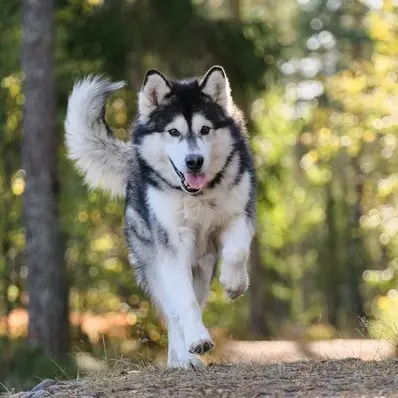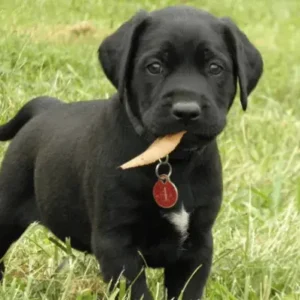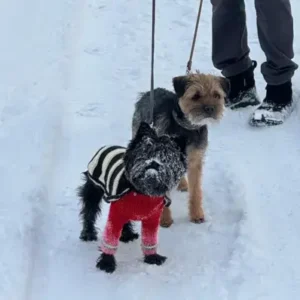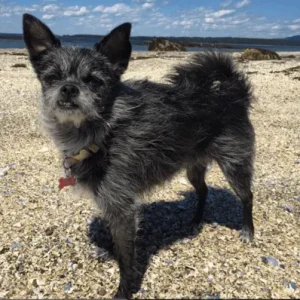Alaskan Malamute History/Origin
The Alaskan Malamute holds a prestigious place as one of the oldest Arctic sled dog breeds, renowned for its strength and endurance.
Originally used for heavy freighting and pulling loads at slow speeds, these tough dogs likely crossed the Bering Strait with Siberian nomads thousands of years ago.
Their name, “Malamute,” honors the northwestern Alaskan Mahlemut tribe, who played a pivotal role in their development and preservation.
Historically, Malamutes were indispensable to Arctic communities, performing different duties. Their roles included sled pulling, packing supplies, hunting, and safeguarding against predators like bears.
During the Gold Rush in the late 1800s, other breeds were crossed with Malamutes, threatening the purebred. After that, multiple Malamutes were employed in World War II, nearly wiping them out. But efforts were made to preserve them, and in 1935, they were officially recognized by the American Kennel Club under the Working Group.
Today, Malamutes are still popular for sledding and winter sports. They can also be great pets in warmer climates, enjoying activities like hiking and running.
Arctic sled dog -Source: AKC.org
Alaskan Malamute Personality
The Alaskan Malamute’s personality is as fascinating as its history. Malamutes are deeply loyal and devoted companions who are renowned for their friendly and affectionate nature.
Their heritage as working sled dogs has instilled in them a strong pack mentality, making them highly sociable and cooperative animals. They enjoy being surrounded by their loved ones and are happiest when included in family activities.
Despite their independent streak, Alaskan Malamutes are known for their friendly and playful nature, especially towards children. However, as with any large breed, supervision is recommended to ensure safe and respectful interactions between dogs and children.
- Temperament
While their affectionate nature is undeniable, Alaskan Malamutes also have a streak of independence that stems from their long history as self-reliant working dogs.
This independence can sometimes turn into stubbornness, particularly when they feel their judgment is superior to that of their human companions.
Consistent training and firm leadership are essential when raising an Alaskan Malamute. While they are intelligent, they may challenge authority if they sense inconsistency or weakness in their owners.
Establishing clear boundaries and providing positive reinforcement is key to fostering a harmonious relationship with these majestic dogs.
Alaskan Malamute Physical Appearance
Alaskan Malamute is one of the dog breeds that is known for their well-proportioned bodies with strong muscles and an athletic build. They have sturdy, straight legs and deep chests, which help them breathe efficiently and maintain endurance.
Their heads are broad, with alert, triangular ears and warm, intelligent almond-shaped eyes typically in brown or amber colors.
They have powerful jaws and a distinct black nose that stands out against their lighter fur. Their tails are fluffy and carried gracefully over their backs, adding to their dignified appearance.
- Alaskan Malamute Size
The giant Alaskan Malamutes are large dogs with a sturdy build. Males typically stand between 23 to 25 inches at the shoulder, while females are slightly smaller, ranging from 22 to 24 inches.
An adult Malamute can weigh up to 90 pounds. While an average Alaskan Malamute baby can weigh around 40 pounds.
Their athletic physique reflects their heritage as working sled dogs, capable of hauling heavy loads over long distances.
- Coat Colors
One of the most striking features of the Alaskan Malamute is its coat, which comes in various colors, including shades of gray, black, sable, and red. The usual base color is white.
Their thick double coat provides insulation against the cold Arctic climate, consisting of a dense, wooly undercoat and a longer, coarser outer coat. This luxurious fur not only protects them from harsh weather conditions but also enhances their majestic appearance.
Alaskan Malamute Gender Differences
Male Alaskan Malamutes often have slightly larger and more muscular builds than females. However, it’s important to note that individual dogs may vary regardless of gender.
While some female Alaskan Malamutes may exhibit stubbornness, this trait is not exclusive to them and can also be present in males. When training and interacting with Alaskan Malamutes, it’s essential to consider each dog’s unique personality and temperament rather than relying solely on gender stereotypes.
Alaskan Malamute Feed/Nutrition
Your Malamute needs a healthy diet because they’re big and energetic. You should include high-quality wet and dry dog food in their diet to ensure they receive all the necessary nutrients. Additionally, you can offer safe vegetables like broccoli and corn in moderation as healthy treats. Their average intake is about 3 cups of dry food.
It’s important to portion their food based on their age, weight, and activity level. This helps keep them healthy and strong. Giving them too much food can make them overweight, which can cause health problems.
It’s always a good idea to consult a professional vet to determine your Malamute’s optimal diet.
Alaskan Malamute Health
As with any breed of dog, they are susceptible to certain health concerns.
- Elbow Dysplasia: Like hip dysplasia, elbow dysplasia is a condition in which the elbow joint doesn’t develop properly. This, too, can cause pain and lameness in affected dogs. Elbow dysplasia is less common than hip dysplasia in Alaskan malamutes, but it’s still something to be aware of. While Alaskan Malamutes can be susceptible to elbow dysplasia, it’s worth noting that not all individuals will develop this condition. Responsible breeding practices and regular veterinary check-ups can help mitigate the risk.
- Canine Gastric Torsion: Also known as bloat (GDV) is a condition in which the stomach becomes bloated with gas and air and twists on itself. This is a potentially life-threatening condition that requires immediate veterinary treatment. However, while it’s crucial to be aware of the symptoms and seek immediate veterinary care if necessary. It’s important to remember that not all Malamutes will experience this issue.
- Canine Influenza virus (CIV): CIV is a virus that affects dogs’ respiratory systems and can cause severe illness, especially in puppies and senior dogs. Alaskan malamutes are particularly susceptible to this virus, so it’s important to vaccinate your dog against it and to keep him away from other dogs who may be sick. It’s also important to consult with a veterinarian for personalized recommendations based on the individual dog’s risk factors and health history.
- Pneumonia: Pneumonia is an infection of the lungs that bacteria, viruses, or fungi can cause. Symptoms include coughing, difficulty breathing, and lethargy. It can be fatal if not treated promptly, so it’s important to get your dog to the vet immediately if you think he may have pneumonia. While the condition can be serious, with proper treatment, many dogs can recover fully.
Emphasizing the importance of proactive care and veterinary guidance helps owners better prepare to address potential issues while enjoying a fulfilling relationship with their Alaskan Malamutes.
Alaskan Malamute Care and Grooming
Taking care of your Alaskan Malamute’s coat is important because they have a thick double coat that sheds a lot, especially when the seasons change.
You’ll need to groom them regularly by brushing their coats and giving them baths once in a while to keep them clean and avoid mats in their fur.
Apart from grooming, your Malamute needs plenty of exercise to keep them happy and healthy. They love being active, so taking them for walks, hikes, or even runs is essential to prevent boredom and keep their bodies and minds in good shape.
Providing them with enough physical activity helps them release their energy and stay mentally stimulated.
Additionally, don’t forget to check their ears regularly for any signs of infection and trim their nails when needed to keep them comfortable and prevent overgrowth.
Taking care of your Malamute’s grooming, exercise, and potty training needs ensures they stay healthy, happy, and well-behaved.
Alaskan Malamute Price
The typical Alaskan Malamute puppy price can go up to $3000. When getting an Alaskan Malamute puppy, it’s essential to buy from a reputable breeder.
Alaskan Malamute Rescue Groups
If you’re looking to adopt a Malamute, several rescue organizations and shelter homes rescue dogs offer them a chance of a loving home.
Interesting Facts
- The Alaskan Malamute has a fascinating history that spans thousands of years. Dating back to around 5,000 years ago, these dogs were companions and working partners to the first settlers of North America.
- During World War I, around 450 Alaskan Malamutes were transported to France to deliver essential supplies to French army troops stationed in remote mountain outposts.
- Alaskan Malamutes were used to portray the direwolves in the popular TV series “Game of Thrones.” Their wolf-like appearance made them perfect for the roles, particularly in the early seasons.
- Based on Jack London’s famous novel, “Call of the Wild” features Alaskan Malamutes as part of the sled dog.
Source: Bark and Swagger
Source: The movie Spoiler
- Alaskan Malamutes were featured in a Breed Judging Show in 2023
Best For
Alaskan Malamutes excel in a variety of tasks, including sled pulling, search and rescue missions, and therapy and assistance work. They also shine in competitive sports such as weight pulling and agility, demonstrating their versatility and adaptability.
Alaskan Malamute Top Names
| Male Alaskan Malamute Names | Female Alaskan Malamute Names |
| Kodiak | Aurora |
| Thor | Kona |
| Denali | Luna |
| Bear | Sasha |
| Nanook | Maya |









 Arctic sled dog -Source:
Arctic sled dog -Source: 

 Grey and white Alaskan Malamute- Source:
Grey and white Alaskan Malamute- Source:  White and Sable Alaskan Malamute Puppy- Source:
White and Sable Alaskan Malamute Puppy- Source: 
 Source:
Source:  Source:
Source: 






